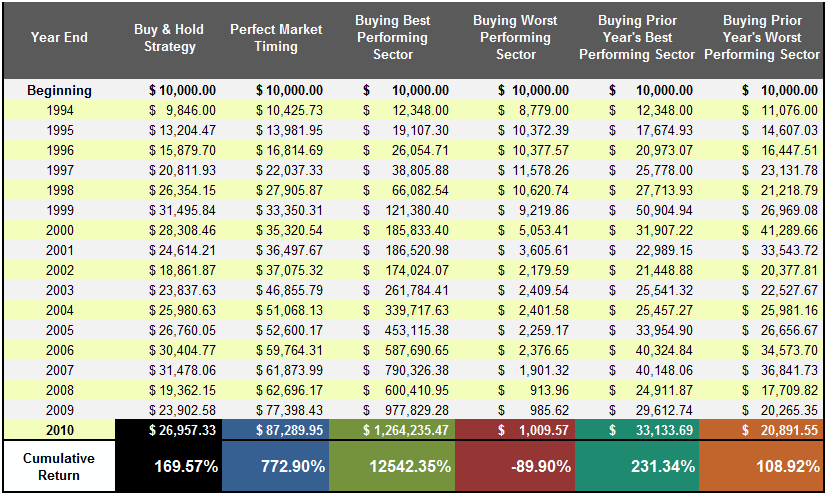How an ETF Sector Rotation Strategy Works
Post on: 16 Март, 2015 No Comment

All News:
Exchange traded funds (ETFs) provide investors with the opportunity to gain exposure to the different sectors and themes in the global markets. Sector rotation is one strategy that could enhance the performance of a portfolio and increase diversification.
Investors who engage in sector rotation hold an overweight position in strong sectors and underweight position in weaker sectors, Hans Wagner for Investopedia instructs. The performance of the various sectors can be affected by the changing business cycle, the time of the year or geographic location.
Through the use of ETFs, investors may focus on specific sector-themed ETFs without having to peruse all the available companies out there. Sector allocation is a disciplined strategy style in which investors will need to be actively selecting sectors that they expect will perform and be ready for possible long-term time horizons. [5 Trading Rules for ETF Investors. ]
Wagner points out three strategy styles that investors can expect in the sector rotation method:
- Economic Cycle. Sam Stovall of Standard & Poors theorizes that different industry sectors perform better at different stages of the economic cycle. Investors following this strategy should buy the into next sector that is moving up while dumping sectors that have reached their peak as defined by the economic cycle. It should be noted that the economy doesnt always follow the economic cycle as exactly defined, and incorrectly timing entry or exit points may lead to losses. [5 ETFs That Are Holding Up. ]
- Calendar year. Before students go back to school, the mid-summer period often creates higher sales for retailers. The holiday season provides retailers with higher sales and travel-related opportunities. The summer driving season would provide a jump in demand for gasoline and diesel, which makes it a good opportunity for oil refiners. These are just some of the many examples of cycle-specific consumer events apropos of the various periods of the year.
- Geography. Investors may also look to ETFs that take advantage of potential gains in the various parts of the world. For instance, a country or region may soon benefit from greater demand for their exports. If a countrys economy is set to expand, investors could look for sector ETFs, like in energy or infrastructure, that support the countrys growth. [How to Stop Following the Herd. ]

Every investor needs a simple strategy. While these points are valid ones to keep in mind, trend following is an easy buy and sell discipline that investors can employ quickly. It can be used to spot uptrends and downtrends while helping mitigate the negative effects that emotions can have on your investment decisions. [How to Follow Trends. ]
For more information on investing in ETFs, visit our ETF 101 category .
Max Chen contributed to this article.
The opinions and forecasts expressed herein are solely those of Tom Lydon, and may not actually come to pass. Information on this site should not be used or construed as an offer to sell, a solicitation of an offer to buy, or a recommendation for any product.














